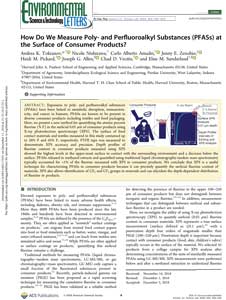 Tokranov, Andrea K., Nicole Nishizawa, Carlo Alberto Amadei, Jenny E. Zenobio, Heidi M Pickard, Joseph G. Allen, Chad D. Vecitis, and Elsie M. Sunderland. How Do We Measure Poly- and Perfluoroalkyl Substances (PFAS) at the Surface of Consumer Products? Environmental Science & Technology Letters (2018).
Tokranov, Andrea K., Nicole Nishizawa, Carlo Alberto Amadei, Jenny E. Zenobio, Heidi M Pickard, Joseph G. Allen, Chad D. Vecitis, and Elsie M. Sunderland. How Do We Measure Poly- and Perfluoroalkyl Substances (PFAS) at the Surface of Consumer Products? Environmental Science & Technology Letters (2018).
Exposures to poly- and perfluoroalkyl substances (PFAS) have been linked to metabolic disruption, immunotoxicity, and cancer in humans. PFAS are known to be present in diverse consumer products including textiles and food packaging. Here, we present a new method for quantifying the atomic percent fluorine (% F) in the surficial 0.01 μm of consumer products using X-ray photoelectron spectroscopy (XPS). The surface of food contact materials and textiles measured in this study contained up to 28% F and 45% F, respectively. PTFE tape was measured to demonstrate XPS accuracy and precision. Depth profiles of fluorine content in consumer products measured using XPS showed the highest levels at the upper-most surface in contact with the surrounding environment and a decrease below the surface. PFAS released in methanol extracts and quantified using traditional liquid chromatography-tandem mass spectrometry typically accounted for <1% of the fluorine measured with XPS in consumer products. We conclude that XPS is a useful technique for characterizing PFAS in consumer products because it can precisely quantify the surficial fluorine content of materials. XPS also allows identification of CF2 and CF3 groups in materials and can elucidate the depth-dependent distribution of fluorine in products.

